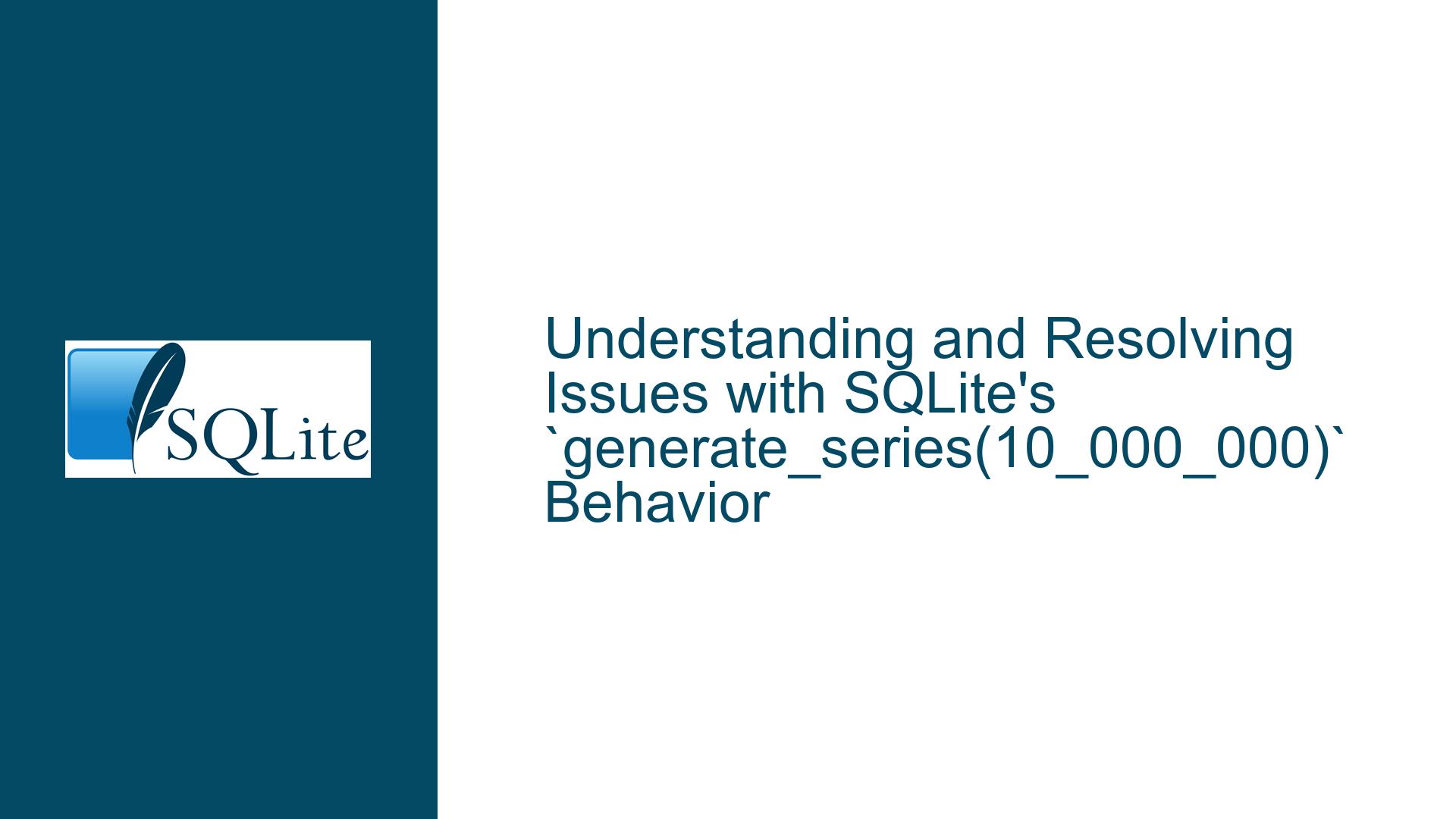and Resolving Issues with SQLite’s `generate_series(10_000_000)` Behavior
The Current Behavior of generate_series(10_000_000) and Its Limitations
The generate_series() function in SQLite is a powerful tool for generating a sequence of numbers, which can be particularly useful for creating test data, iterating through ranges, or performing calculations over a series of values. However, the current implementation of the single-parameter version of generate_series() has a significant limitation that affects its practicality in real-world scenarios.
When you invoke generate_series(10_000_000), the function interprets this as generate_series(10_000_000, 4G), where 4G represents a large upper bound (4 billion). This behavior is problematic for several reasons. First, the upper bound of 4 billion is arbitrary and often unnecessary for most use cases. Second, generating a series that spans from 10 million to 4 billion can lead to performance issues, especially when the system runs out of memory (OOM) due to the sheer size of the generated sequence. This makes the function less useful in practice, as it often fails to execute successfully in environments with limited resources.
The issue becomes more apparent when comparing SQLite’s behavior with that of other databases, such as DuckDB. In DuckDB, the single-parameter version of generate_series() is interpreted as generate_series(1, N), where N is the provided parameter. This interpretation is more intuitive and practical, as it generates a sequence starting from 1 up to the specified number, which is a common use case for such functions. For example, generate_series(10_000_000) in DuckDB generates a sequence from 1 to 10 million, which is both manageable and useful for most applications.
The discrepancy between SQLite’s and DuckDB’s implementations of generate_series() highlights a need for reevaluating the default behavior of the function in SQLite. While the current behavior may have been designed with specific use cases in mind, it often leads to inefficiencies and failures, particularly in resource-constrained environments. This raises the question of whether SQLite should adopt a more user-friendly and practical approach, similar to DuckDB’s implementation.
Potential Backward Compatibility Concerns with Changing generate_series() Behavior
One of the primary concerns with modifying the behavior of generate_series(10_000_000) is the potential impact on backward compatibility. Changing the function’s behavior could break existing applications that rely on the current implementation, leading to unexpected results or failures. This is a significant consideration, as backward compatibility is a critical aspect of maintaining stability and trust in a database system.
However, it is worth noting that the current behavior of generate_series(10_000_000) is rarely used in practice due to its inherent limitations. Most applications that require large sequences are likely to encounter memory issues before the function can complete successfully. As a result, the impact of changing the behavior may be minimal, as few applications would be affected by the modification.
Moreover, the benefits of adopting a more intuitive and practical approach, such as DuckDB’s implementation, could outweigh the potential drawbacks. By aligning the behavior of generate_series() with user expectations and common use cases, SQLite could improve the overall usability and performance of the function. This would make it more accessible to a broader range of applications and reduce the likelihood of failures due to memory constraints.
To mitigate the risks associated with backward compatibility, SQLite could introduce the new behavior as an optional feature, allowing users to choose between the current and proposed implementations. This approach would provide a smooth transition path for existing applications while enabling new applications to take advantage of the improved functionality. Additionally, SQLite could deprecate the current behavior over time, encouraging users to migrate to the new implementation gradually.
Strategies for Troubleshooting and Resolving Issues with generate_series(10_000_000)
To address the issues with generate_series(10_000_000), it is essential to consider both short-term and long-term solutions. In the short term, users can employ several strategies to work around the limitations of the current implementation. These strategies include manually specifying the range of the series, using alternative functions, or optimizing the environment to handle larger sequences.
One effective workaround is to explicitly define the range of the series using the two-parameter version of generate_series(). For example, instead of using generate_series(10_000_000), users can specify generate_series(1, 10_000_000) to generate a sequence from 1 to 10 million. This approach avoids the pitfalls of the single-parameter version and ensures that the series is generated within manageable limits.
Another option is to use alternative functions or techniques to achieve the desired result. For instance, users can create a custom function or script to generate the sequence and insert it into a temporary table. This approach provides greater control over the sequence generation process and allows users to tailor the implementation to their specific needs.
Optimizing the environment to handle larger sequences is another potential solution. This can involve increasing the available memory, optimizing the database configuration, or using a more powerful system to execute the query. While these measures may not address the root cause of the issue, they can help mitigate the impact of the current behavior and enable users to work with larger sequences more effectively.
In the long term, the most effective solution is to modify the behavior of generate_series(10_000_000) to align with user expectations and common use cases. This would involve changing the function to interpret the single parameter as the upper bound of a sequence starting from 1, similar to DuckDB’s implementation. To ensure a smooth transition, SQLite could introduce the new behavior as an optional feature and provide clear documentation and migration guidelines for users.
Additionally, SQLite could enhance the generate_series() function by adding support for more advanced features, such as custom step values, negative ranges, or non-integer sequences. These enhancements would further improve the flexibility and usability of the function, making it a more versatile tool for a wide range of applications.
In conclusion, the current behavior of generate_series(10_000_000) in SQLite presents several challenges that limit its practicality and performance. By understanding the limitations, addressing potential backward compatibility concerns, and implementing effective troubleshooting strategies, users can work around these issues and achieve their desired results. In the long term, modifying the behavior of the function to align with user expectations and common use cases would provide a more intuitive and practical solution, enhancing the overall usability and performance of SQLite.






